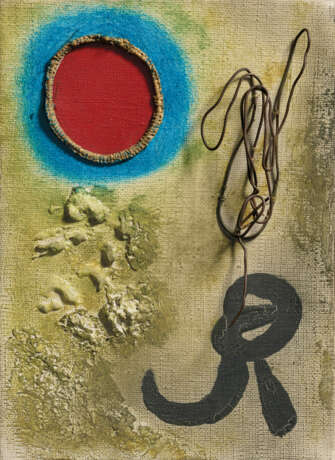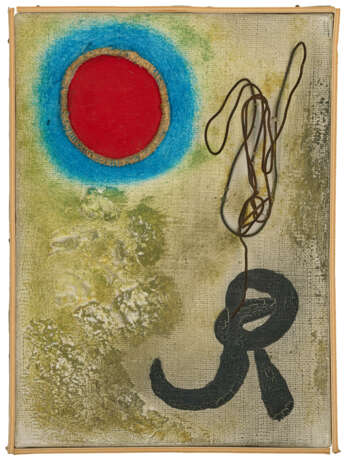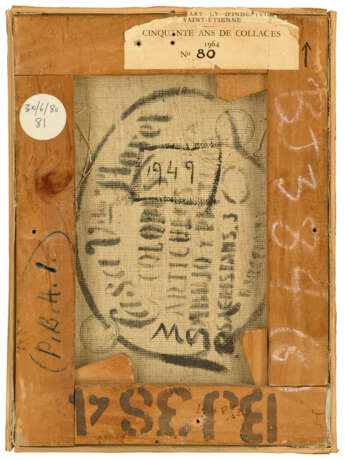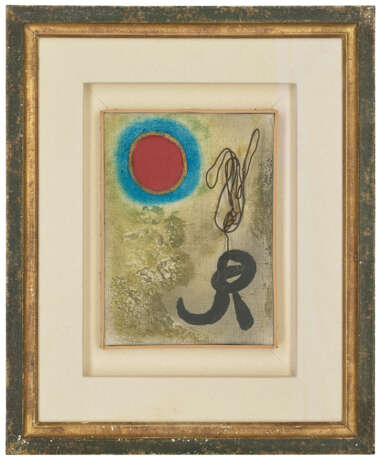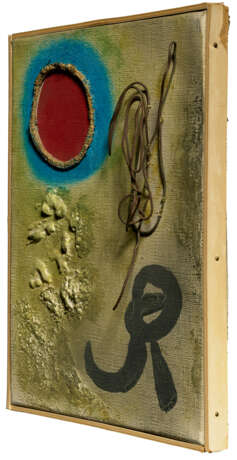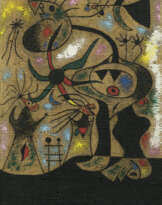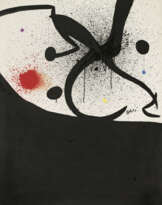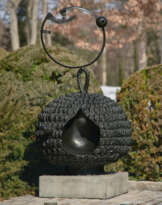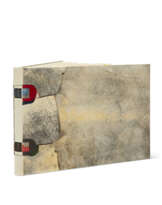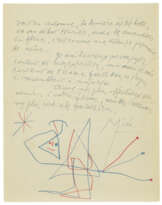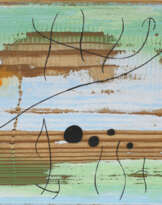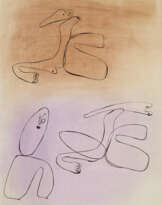ID 929390
Los 2 | Joan Miró (1893-1983)
Schätzwert
€ 450 000 – 650 000
Femme devant le soleil
signé et daté '1949 Miró.' (au revers)
huile, corde et fil de fer sur toile
22.2 x 16.3 cm.
Exécuté en 1949
signed and dated '1949 Miró.' (on the reverse)
oil, rope and iron wire on canvas
8 3/4 x 6 3/8 in.
Executed in 1949
Provenance
Galerie Maeght, Paris (avant 1956 et jusqu'à au moins 1970).
Collection particulière, Milan; vente, Christie's, Londres, 30 juin 1980, lot 81 (titré 'Peinture-objet').
Collection particulière, États-Unis (acquis au cours de cette vente).
Collection particulière, États-Unis; vente, Sotheby's, Paris, 1 juin 2011, lot 47.
Acquis au cours de cette vente par le propriétaire actuel.
Literature
J. Prévert et G. Ribemont-Dessaignes, Joan Miró, Paris, 1956, p. 171 (illustré; titré 'Tableau-objet').
J. Dupin, Miró, Cologne et Paris, 1961, p. 541, no. 758 (illustré; titré 'Peinture').
M. Tapié, Joan Miró, L'Art de notre temps, Milan, 1970, p. 21, no. 62 (illustré, fig. 62; titré 'Peinture').
G. Weelen, Miró, Paris, 1984, p. 147, no. 195 (illustré).
J. Dupin et A. Lelong-Mainaud, Joan Miró, Catalogue raisonné, Paintings, 1942-1955, Paris, 2001, vol. III, p. 159, no. 866 (illustré en couleurs).
Exhibited
Bruxelles, Palais des Beaux-Arts et Amsterdam, Stedelijk Museum, Joan Miró, janvier-mars 1956, no. 49 (illustré; titré 'Toile-objet').
Bâle, Kunsthalle, Joan Miró, mars-avril 1956, p. 11, no. 62 (titré 'Toile-objet').
Saint-Étienne, Musée d'art et d'industrie, Cinquante ans de "collages", Papiers collés, assemblages, collages, du cubisme a' nos jours, juin-septembre 1964, no. 80 (titré 'Toile-objet').
Special notice
Artist's Resale Right ("droit de Suite").
If the Artist's Resale Right Regulations 2006 apply to this lot, the buyer also agrees to pay us an amount equal to the resale royalty provided for in those Regulations, and we undertake to the buyer to pay such amount to the artist's collection agent.
ƒ: In addition to the regular Buyer’s premium, a commission of 5.5%
inclusive of VAT of the hammer price will be charged to the buyer.
It will be refunded to the Buyer upon proof of export of the lot
outside the European Union within the legal time limit.
(Please refer to section VAT refunds)
Post lot text
"Si je venais à manquer de matériaux pour travailler, aller sur la plage et faire des graphismes sur le sable avec un roseau, dessiner en pissant sur la terre sèche, dessiner dans l'espace vide le graphique du chant des oiseaux, le bruit de l'eau et du vent et d'une roue de charrette et le chant des insectes, que tout cela soit ensuite emporté par le vent, par l'eau, mais avoir la conviction que toutes ces pures réalisations de mon esprit auront par magie et par miracle une répercussion dans l'esprit des autres hommes. "
Joan Miró
« Femme devant le soleil, sur un fond bleu parsemé d'étoiles, captive du soleil rouge, la face rongée par un œil énorme, vert, jaune, blanc à la pupille noire est une pauvre petite chatte déifiée un jour de mélancolie par Ramsès III et découverte dans une frise de son temple solaire de Medinet Habou.
La Toile-objet de 1949, mélangeant signe peint, couture et relief semble être un débris qu'un coup de pioche vient de faire apparaître aux yeux d'un fellah éberlué par sa trouvaille. Mais le jeu se complique car cette petite toile ne relève d'aucune civilisation ancienne et connue, pourtant elle y fait rêver - pouvoir de suggestion de la métaphore. »
G. Weelen, Miró, Paris, 1984, p. 147, no. 195 (illustré).
Après avoir connu le succès à New York et Paris, Joan Miró revient vivre à Barcelone en 1949 et profite de son retour en Espagne pour laisser libre cours à ses rêves. Des moments de réflexions aux impulsions frénétiques, son œuvre est, à cette période, particulièrement féconde. Sa peinture est spontanée, imprégnée d’une expérience poétique sensible.
Miró poursuit alors ses recherches entreprises quelques années plus tôt sur l’utilisation de matériaux improbables qui annoncent sa période dite d'anti-peinture. Arpentant les plages catalanes près de sa maison familiale à Montroig, l'artiste cueille sur le sable des objets naufragés et autres curiosités à l'abandon qu'il intègre par la suite à ses collages et sculptures d'assemblage. C'est son œil de peintre, toujours vif, qui lui permet de discerner en un regard le potentiel plastique et la charge émotive qui résident dans le bord arrondi d'un coquillage, l'angle oblique d'un morceau de bois, ou encore la courbe d’un fil de fer. « Il ne faut pas oublier qu'il n'existe guère d'éléments non-figuratifs dans la peinture de Miró », rappelait Bill Rubin, ancien conservateur au Museum of Modern Art, à New York. « Chaque forme qui apparaît dans sa peinture est associée, sur le plan métaphorique, à quelque chose d'extérieur à la toile ; chaque élément émet une allusion, aussi évasive et insondable soit-elle » (W. Rubin, Miró in the Collection of the Museum of Modern Art, cat. exp., New York, 1973, p. 51). Ici, l'énigmatique figure féminine semble prendre vie au contact du monde mystérieux, céleste et fantasque dans lequel nous entraîne Miró. Réduite à l'essentiel par quelques lignes noires très graphiques, la femme paraît danser, dialoguant, dans une ambiance onirique propre à Miró, avec les éléments l’entourant.
Jacques Dupin dépeint avec précision cette période unique de production artistique chez Miró: “ [les peintures de 1949-1950] forment deux séries distinctes auxquelles le peintre a travaillé simultanément : d'une part, des peintures très élaborées, d'autre part, des peintures totalement spontanées. Les premières, œuvres d'une incroyable précision, renvoient après toutes ces années au miniaturisme […] et à la pureté vertigineuse des Constellations. Les autres, en revanche, ressemblent à des improvisations libres, réalisées sur le moment ; leur rapidité d'exécution et l'autonomie de leur geste leur sont aussi inhérentes que l'élaboration patiente des tableaux plus fouillés ou étudiés. Les premières sont avant tout des ‘créations’, les secondes des ‘communications’. Elles correspondent dans le tempérament du peintre à des moments de réflexion et à des moments d'impulsion, qui se succèdent naturellement comme l'inspiration et l'expiration. Nous avons eu maintes fois l'occasion de décrire et de contraster les deux types d'écriture manuscrite en cause. Jusqu'à présent, elles apparaissaient le plus souvent dans une seule et même toile ; jamais elles n'ont été aussi clairement séparées que dans ces œuvres de 1949 et 1950 » (J. Dupin, Joan Miró, Life and Work, New York, 1962, p. 393).
Véritable moment d’impulsion et de spontanéité peinte sur une toile à la trame rugueuse et texturé, Femme devant le soleil nous plonge dans un environnement vibrant et fantaisiste. Avec une conviction totale, Miró a créé un terrain de jeu visuel dynamique et magique.
“If I ever ran out of materials to work with, going to the beach and tracing patterns in the sand with a reed, peeing designs onto the dry earth, drawing the sound of birdsong, the sound of water and wind and a cart wheel and the song of insects in the empty space, then letting it all be swept away by the wind, the water, but having the conviction that all these pure realizations of my mind would magically and miraculously reverberate in the minds of other men.”
Joan Miró
“Femme devant le soleil, on a blue background dotted with stars, captive of the red sun, her face gnawed by a giant green, yellow and white eye with a black pupil, is a poor little cat deified one melancholic day by Ramses III and discovered in a frieze of his solar temple at Medinet Habu.
The canvas-object of 1949, mixing painted sign, stitching and relief, seems to be a piece of debris that a blow of a pickaxe has just exposed to the eyes of a fellah stunned by his find. But the game gets more complicated because this small canvas does not belong to any ancient known civilisation, yet it makes one dream about it – the suggestive power of metaphor.”
G. Weelen, Miró, Paris, 1984, p. 147, no. 195 (illustrated).
After his success in New York and Paris, Joan Miró returned to Barcelona in 1949 and took advantage of his return to Spain to let his dreams flow freely. From contemplative moments to frenetic impulses, his output during this period was particularly productive. His painting was spontaneous, imbued with a sensitive poetic experience.
Miró then continued the research he had begun a few years earlier on the use of improbable materials that heralded his so-called “anti-painting” period. Wandering the Catalan beaches near his family home in Montroig, the artist gathered washed-up objects and other abandoned curiosities from the sand, which he then incorporated into his collages and assemblage sculptures. It was his keen painter’s eye that enabled him to perceive in a single glance the aesthetic potential and emotional charge that lay in the rounded edge of a shell, the oblique angle of a piece of wood, the curve of a wire. “It must be remembered that there is no such thing as a nonfigurative element in Miró’s painting,” recalled Bill Rubin, former curator at the Museum of Modern Art in New York. “However elliptical, however distant the illusion, every form in his paintings is associated metaphorically with something outside the work (W. Rubin, Miró in the Collection of the Museum of Modern Art, exp. cat., New York, 1973, p. 51). Here, the enigmatic female figure seems to come alive in the mysterious, celestial, fantastical world Miró draws us into. Pared down to the essentials by a few very graphic black lines, the woman appears to be dancing, conversing with the elements around her in Miró’s own dreamlike atmosphere.
Jacques Dupin accurately described this unique period of Miró’s artistic production: “[the paintings from 1949–1950] form two distinct series which the painter worked on simultaneously: highly elaborate paintings and completely spontaneous paintings. The former, works of incredible precision, return after all these years to the miniaturism […] and dizzying purity of the Constellations. The latter, on the other hand, resemble free improvisations, performed in the moment; their speed of execution and the autonomy of their technique are as inherent as the patient development of the more elaborate or studied paintings. The former are essentially ‘creations’, the latter ‘communications’. They correspond to moments of reflection and impulse in the painter’s temperament, which naturally alternate like breathing in and out. We have had many opportunities to describe and contrast the two types of techniques involved. Until then, they usually appeared in one and the same canvas; never were they so clearly separated as in these works from 1949 and 1950.” (J. Dupin, Joan Miró, Life and Work, New York, 1962, p. 393).
A genuine moment of impulse and spontaneity painted on a rough and textured canvas, Femme devant le soleil plunges us into a vibrant and fanciful world. With total conviction, Miró created a magical, dynamic visual playground.
| Künstler: | Joan Miró (1893 - 1983) |
|---|---|
| Angewandte Technik: | Öl auf Leinwand |
| Kategorie des Auktionshauses: | Gemälde |
| Künstler: | Joan Miró (1893 - 1983) |
|---|---|
| Angewandte Technik: | Öl auf Leinwand |
| Kategorie des Auktionshauses: | Gemälde |
| Adresse der Versteigerung |
CHRISTIE'S 9 Avenue Matignon 75008 Paris Frankreich | ||||||||||||||
|---|---|---|---|---|---|---|---|---|---|---|---|---|---|---|---|
| Vorschau |
| ||||||||||||||
| Telefon | +33 (0)1 40 76 85 85 | ||||||||||||||
| Fax | +33 (0)1 40 76 85 86 | ||||||||||||||
| Nutzungsbedingungen | Nutzungsbedingungen | ||||||||||||||
| Versand |
Postdienst Kurierdienst Selbstabholung | ||||||||||||||
| Zahlungsarten |
Banküberweisung | ||||||||||||||
| Geschäftszeiten | Geschäftszeiten
|
